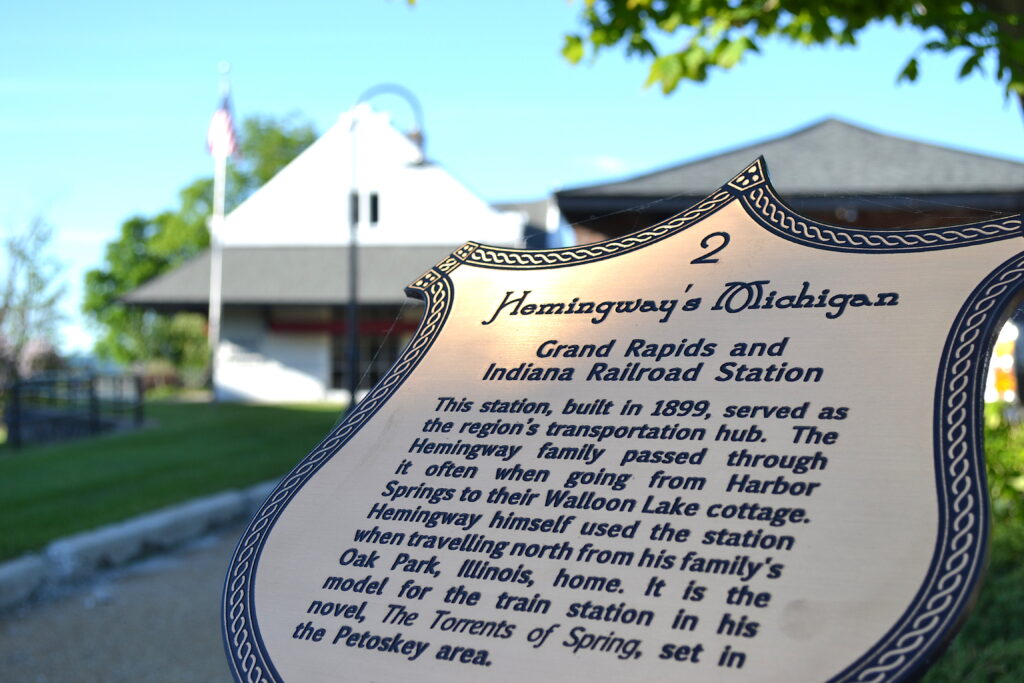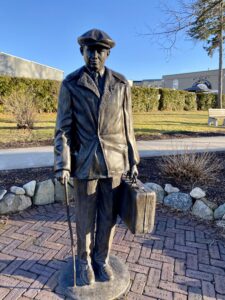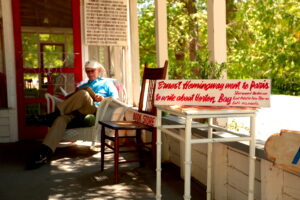Walk in Ernest Hemingway’s Footsteps

By Jackie Sheckler Finch
With a copy of my favorite Ernest Hemingway book in my backpack, I survey a sculpture of the author as a young man. Based on a 1920 photo, the artwork shows Hemingway leaving Petoskey after recovering from the life-threatening wounds he suffered in Italy during World War I.
 Standing in downtown Petoskey’s Pennsylvania Park, Hemingway’s 6-foot frame holds a cane and suitcase as he prepares to board a train. It has been said, however, that a book in the author’s pocket may not be a totally accurate detail. More than likely it is said that the actual Hemingway would be carrying a liquor flask in his pocket—as history shows he did like his drink.
Standing in downtown Petoskey’s Pennsylvania Park, Hemingway’s 6-foot frame holds a cane and suitcase as he prepares to board a train. It has been said, however, that a book in the author’s pocket may not be a totally accurate detail. More than likely it is said that the actual Hemingway would be carrying a liquor flask in his pocket—as history shows he did like his drink.
I’ve followed the Nobel Prize-winning author on his familiar haunts in Cuba, Spain, and Key West, Florida. But this was my first time walking in his Michigan footsteps, and it is a fascinating trail.
“It was here in Petoskey that Hemingway decided to follow his dream of becoming a writer and ‘To write about what he knew best,’” says Christopher Struble, president of the Michigan Hemingway Society, an organization that has offered Hemingway tours for 20 years.
Hemingway’s parents had fallen in love with the area and built a summer cottage on Walloon Lake. During the first 23 years of his life, Hemingway’s family spent summers in the Petoskey area, which he called
“a priceless place.”
 A good way to start my Hemingway trip was to visit the Little Traverse Historical Museum in a former railroad depot on Petoskey’s waterfront. The museum has a nice collection of Hemingway memorabilia. From there, I headed over to City Park Grill, formerly known as the Annex, where Hemingway would take the next-to-last seat on the left at the Victorian-era pub. With the seat open, I slid in to savor a scotch and water in his honor.
A good way to start my Hemingway trip was to visit the Little Traverse Historical Museum in a former railroad depot on Petoskey’s waterfront. The museum has a nice collection of Hemingway memorabilia. From there, I headed over to City Park Grill, formerly known as the Annex, where Hemingway would take the next-to-last seat on the left at the Victorian-era pub. With the seat open, I slid in to savor a scotch and water in his honor.
Next was the majestic Stafford’s Perry Hotel where Hemingway stayed in 1916. Guests can now enjoy one of the 75 guest rooms and relax on the expansive porch while watching “The Million Dollar Sunset” for which Petoskey is famous.
As for that book I’m carrying, it’s the Hemingway classic I learned to love in junior high, “The Old Man and the Sea.” Petoskey seems the perfect place to reread it and muse about how Hemingway’s Michigan memories influence his legendary works.
As Struble concludes, “Hemingway wrote so many stories about north Michigan right up until his death when he was working on yet another northern Michigan story, aptly named, ‘The Last Good Country.’”
Photos Provided By: Petoskey Area Visitors Bureau

